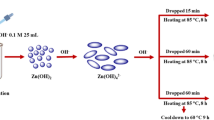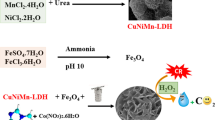Abstract
Pure CuFe2O4 nanoparticles were synthesized using sol–gel method technique. Effect of Zr/Cu substitution (Cu1−xZrx, where x = 0.25, 0.50, 0.75, and 1.00) on the structural, morphological, and magnetic properties was studied by X-ray diffraction (XRD), scanning electron microscopy (SEM), energy-dispersive X-ray (EDX), infrared Fourier transform infrared (FTIR), and vibrating sample magnetometer (VSM). The photocatalytic behavior of pure CuFe2O4 as well Zr-substituted samples was investigated for degradation of phenol in aqueous solution in the presence of ultraviolet irradiation. The XRD results of pure CuFe2O4 confirmed the formation of single tetragonal structure phase, while introducing zirconium in the structural composition resulted in a decrease in the crystallinity and gradual disappearance of the cuprospinel phase accompanied with appearance of single metal oxides species (Fe2O3, ZrO2, Cu4O3). Based on the scanning (SEM–EDX), the samples consist of agglomerated particles with varying sizes and shapes related to their compositions. The magnetic hysteresis loops of all samples exhibited room temperature ferromagnetism with variable shapes, saturation magnetization, and coercivity values. All samples showed a significant photocatalytic activity when irradiated with ultraviolet light. The highest photocatalytic efficiency (92%) for phenol degradation was achieved through the 25% Zr-substituted sample under irradiation time of 150 min.

Highlights
-
Novel Zr–Cu–Fe metal oxide nanocomposites were synthesized using sol–gel technique.
-
Effect of Zr/Cu substitution percentage on the structural, morphological, and magnetic properties was investigated.
-
The photocatalytic activity of the nanocomposites was also investigated.
-
A significant photocatalytic activity enhancement toward phenol degradation was achieved through Zr/Cu substitution especially at 25%.







Similar content being viewed by others
References
Gleick PH (2002) Dirty-water: estimated deaths from water-related diseases 2000–2020 Oakland: Pacific Institute for studies in Development, environment, and security. pp. 1–12
Brostow W et al. (2009) Polymeric flocculants for wastewater and industrial effluent treatment. J Mater Educ 31(3–4):157–166
Gupta VK et al. (2012) Chemical treatment technologies for waste-water recycling—an overview. RSC Adv 2:6380–6388
Ciabattia I et al. (2009) Demonstration of a treatment system for purification and reuse of laundry wastewater. Desalination 245(1–3):451–459
Kannan S, Dubey A, Knozinger H (2005) Synthesis and characterization of CuMgAl ternary hydrotalcites as catalysts for the hydroxylation of phenol. J Catal 231(2):381–392
Santos A et al. (2006) Wet oxidation of phenol, cresols and nitrophenols catalyzed by activated carbon in acid and basic media. Appl Catal B 65(3):269–281
Kulkarni SJ, Kaware JP (2013) Review on research for removal of phenol from wastewater. Int J Sci Res Publ 3(4):1–5
Villegas LGC et al. (2016) A short review of techniques for phenol removal from wastewater. Curr Pollut Rep 2(3):157–167
Zhu L, Chen B, Shen X (2000) Sorption of phenol, p-nitrophenol, and aniline to dual-cation organobentonites from water. Environ Sci Technol 34(3):468–475
Mallek M et al. (2018) Granulated cork as biosorbent for the removal of phenol derivatives and emerging contaminants. J Environ Manag 223:576–585
Zhu Z et al. (2018) Enzyme-assisted extraction of polyphenol from edible lotus (Nelumbo nucifera) rhizome knot: ultra-filtration performance and HPLC-MS2 profile. Food Res Int 111:291–298
Rezakazemi M, Maghami M, Mohammadi T (2018) Wastewaters treatment containing phenol and ammonium using aerobic submerged membrane bioreactor. Chem Cent J 12(1):79
Wu D et al. (2019) Feasibility and energy consumption analysis of phenol removal from salty wastewater by electro-electrodialysis. Sep Purif Technol 215:44–50
Védrine J (2017) Heterogeneous catalysis on metal oxides. Catalysts 7(11):341
Sudha D, Sivakumar P (2015) Review on the photocatalytic activity of various composite catalysts. Chem Eng Process 97:112–133
Wahba MA, Yakout SM (2019) Innovative visible light photocatalytic activity for V-doped ZrO2 structure: optical, morphological, and magnetic properties. J Sol-Gel Sci Technol 92(3):628–640
Adhikari S, Sarkar D (2015) Metal oxide semiconductors for dye degradation. Mater Res Bull 72:220–228
Chen X et al. (2015) The synthesis of ZnO/SnO2 porous nanofibers for dye adsorption and degradation. Dalton Trans 44(7):3034–3042
Gnanasekaran L et al. (2017) Synthesis and characterization of metal oxides (CeO2, CuO, NiO, Mn3O4, SnO2 and ZnO) nanoparticles as photo catalysts for degradation of textile dyes. J Photochem Photobiol B 173:43–49
Reddy LH et al. (2012) Magnetic nanoparticles: design and characterization, toxicity and biocompatibility, pharmaceutical and biomedical applications. Chem Rev 112(11):5818–5878
Linsebigler AL, Lu G, Yates Jr JT (1995) Photocatalysis on TiO2 surfaces: principles, mechanisms, and selected results. Chem Rev 95(3):735–758
Nawle AC et al. (2017) Deposition, characterization, magnetic and optical properties of Zn doped CuFe2O4 thin films. J Alloy Compd 695:1573–1582
Shahbaz Tehrani F et al. (2012) Structural, magnetic, and optical properties of zinc- and copper-substituted nickel ferrite nanocrystals. J Supercond Nov Magn 25(7):2443–2455
Kefeni KK, Mamba BB, Msagati TA (2017) Application of spinel ferrite nanoparticles in water and wastewater treatment: a review. Sep Purif Technol 188:399–422
Nidheesh P (2015) Heterogeneous Fenton catalysts for the abatement of organic pollutants from aqueous solution: a review. Rsc Adv 5(51):40552–40577
Gubbala S et al. (2004) Magnetic properties of nanocrystalline Ni–Zn, Zn–Mn, and Ni–Mn ferrites synthesized by reverse micelle technique. Phys B 348(1-4):317–328
Saafan S et al. (2010) AC and DC conductivity of NiZn ferrite nanoparticles in wet and dry conditions. J Magn Magn Mater 322(16):2369–2374
Singhal S, Chandra K (2007) Cation distribution and magnetic properties in chromium-substituted nickel ferrites prepared using aerosol route. J Solid State Chem 180(1):296–300
Zhang F et al. (2015) Zinc ferrite catalysts for ozonation of aqueous organic contaminants: phenol and bio-treated coking wastewater. Sep Purif Technol 156:625–635
Ding Y et al. (2013) Sulfate radicals induced degradation of tetrabromobisphenol A with nanoscaled magnetic CuFe2O4 as a heterogeneous catalyst of peroxymonosulfate. Appl Catal B 129:153–162
Zhang H et al. (2017) Reuse of Fenton sludge as an iron source for NiFe2O4 synthesis and its application in the Fenton-based process. J Environ Sci 53:1–8
Roonasi P, Nezhad AY (2016) A comparative study of a series of ferrite nanoparticles as heterogeneous catalysts for phenol removal at neutral pH. Mater Chem Phys 172:143–149
Cullity B, Stock Sá (1978) Elements of x-ray diffraction. Addison-Wesley, Reading, MA
Fagal GA et al. (2012) Effect of La2O3-treatment on textural and solid–solid interactions in ferric/cobaltic oxides system. J Solid State Chem 194:162–167
El‐Shobaky GA et al. (2009) Catalytic oxidation of CO by O2 over nanosized CuO–ZnO system prepared under various conditions. Can J Chem Eng 87(5):792–800
Ghanem A et al. (2014) Photocatalytic activity of hyperbranched polyester/TiO2 nanocomposites. Applied. Catal A 472:191–197
Rehim MHA et al. (2016) Photocatalytic activity and antimicrobial properties of paper sheets modified with TiO2/Sodium alginate nanocomposites. Carbohydr Polym 148:194–199
Prince E, Treuting R (1956) The structure of tetragonal copper ferrite. Acta Crystallogr 9(12):1025–1028
Mexmain J (1971) Contribution a l’etude du ferrite cuivreux et de ses solutions solides avec le ferrite cuivrique. Annales de Chimie. Vol 1971. pp. 297–308
Mazen S (2000) Tetravalent ions substitution in Cu–ferrite; structure formation and electrical properties. Mater Chem Phys 62(2):131–138
Cross WB et al. (1999) Self-propagating high-temperature synthesis of ferrites MFe2O4 (M = Mg, Ba, Co, Ni, Cu, Zn); reactions in an external magnetic field. J Mater Chem 9(10):2545–2552
Finger LW, Hazen RM (1980) Crystal structure and isothermal compression of Fe2O3, Cr2O3, and V2O3 to 50 kbars. J Appl Phys 51(10):5362–5367
Suzuki-Muresan T et al. (2010) Minimization of absorption contrast for accurate amorphous phase quantification: application to ZrO2 nanoparticles. J Appl Crystallogr 43(5):1092–1099
O'keeffe M, Bovin J (1978) The crystal structure of paramelaconite Cu4O3. Am Mineral 63(1–2):180–185
Bondars B et al. (1995) Powder diffraction investigations of plasma sprayed zirconia. J Mater Sci 30(6):1621–1625
McCullough Jt, Trueblood K (1959) The crystal structure of baddeleyite (monoclinic ZrO2). Acta Crystallogr 12(7):507–511
Kröger FA (1964) The chemistry of imperfect crystals. North-Holland Pub, Co
Sargent W (1980) Table of periodic properties of the elements. Sargent-Welch Scientific, Skokie, IL
Wahba MA, Mohamed W, Hanna AA (2016) Sol-gel synthesis, characterization of Fe/ZrO2 nanocomposites and their photodegradation activity on indigo carmine and methylene blue textile dyes. Int J ChemTech Res 9(5):914–925
Krinsley DH et al. (2005) Backscattered scanning electron microscopy and image analysis of sediments and sedimentary rocks. University Press, Cambridge
Zeynizadeh B, Gholamiyan E, Gilanizadeh M (2018) Magnetically recoverable CuFe2O4 nanoparticles as an efficient heterogeneous catalyst for green formylation of alcohols. Current Chem Lett 7(4):121–130
Peymanfar R, Azadi F, Yassi Y (2018) Preparation and characterization of CuFe2O4 nanoparticles by the sol-gel method and investigation of its microwave absorption properties at Ku-band frequency using silicone rubber. In Multidisciplinary Digital Publishing Institute Proceedings. Vol. 2, p. 1155
Zhao J et al. (2012) Magnetic and electrochemical properties of CuFe2O4 hollow fibers fabricated by simple electrospinning and direct annealing. CrystEngComm 14(18):5879–5885
Raul PK et al. (2014) CuO nanorods: a potential and efficient adsorbent in water purification. RSC Adv 4(76):40580–40587
Dharmaraj N, Kim C, Kim H (2006) Synthesis and characterisation of zirconium oxide nanofibers by electrospinning. Synth Reactivity Inorg, Met-Org Nano-Met Chem 36(1):29–32
Ranjbar M et al. (2012) Preparation and characterization of tetragonal zirconium oxide nanocrystals from isophthalic acid-zirconium (IV) nanocomposite as a new precursor. International. J Nanosci Nanotechnol 8(4):191–196
Cullity BD, Graham CD (2011) Introduction to magnetic materials. IEEE Press, John Wiley & Sons. Inc., Hoboken, New Jersey
Tehrani FS et al. (2012) Structural, magnetic, and optical properties of zinc-and copper-substituted nickel ferrite nanocrystals. J Supercond Nov Magn 25(7):2443–2455
Hu C, Gao Z, Yang X (2008) One-pot low temperature synthesis of MFe2O4 (M = Co, Ni, Zn) superparamagnetic nanocrystals. J Magn Magn Mater 320(8):L70–L73
Sun S et al. (2004) Monodisperse mfe2o4 (m = Fe, Co, Mn) nanoparticles. J Am Chem Soc 126(1):273–279
Kale A, Gubbala S, Misra R (2004) Magnetic behavior of nanocrystalline nickel ferrite synthesized by the reverse micelle technique. J Magn Magn Mater 277(3):350–358
Faheem M et al. (2018) Synthesis of Cu2O–CuFe2O4 microparticles from Fenton sludge and its application in the Fenton process: the key role of Cu2O in the catalytic degradation of phenol. RSC Adv 8(11):5740–5748
Xu C et al. (2010) Preparation of ZnO/Cu2O compound photocatalyst and application in treating organic dyes. J Hazard Mater 176(1-3):807–813
Lee DW, Yoo BR (2014) Advanced metal oxide (supported) catalysts: synthesis and applications. J Ind Eng Chem 20(6):3947–3959
Murali DS, Aryasomayajula S (2018) Thermal conversion of Cu4O3 into CuO and Cu2O and the electrical properties of magnetron sputtered Cu4O3 thin films. Appl Phys A 124(3):279
Fan Z-J et al. (2010) Facile synthesis of graphene nanosheets via Fe reduction of exfoliated graphite oxide. ACS nano 5(1):191–198
López U et al. (2019) Synthesis and characterization of ZnO-ZrO2 nanocomposites for photocatalytic degradation and mineralization of phenol. J Nanomater 2019(3):1–12.
Tian G et al. (2009) Enhanced photocatalytic activity of S-doped TiO2–ZrO2 nanoparticles under visible-light irradiation. J Hazard Mater 166(2–3):939–944
Author information
Authors and Affiliations
Corresponding author
Ethics declarations
Conflict of interest
The authors declare that they have no conflict of interest.
Additional information
Publisher’s note Springer Nature remains neutral with regard to jurisdictional claims in published maps and institutional affiliations.
Rights and permissions
About this article
Cite this article
Wahba, M.A., Badawy, A.A. Novel Zr–Cu–Fe nanocomposite metal oxides: structural, magnetic and composition activity effects on photodegradation of phenols. J Sol-Gel Sci Technol 94, 637–647 (2020). https://doi.org/10.1007/s10971-019-05190-1
Received:
Accepted:
Published:
Issue Date:
DOI: https://doi.org/10.1007/s10971-019-05190-1




